Table of Contents
Content management systems (CMS) have become increasingly popular for organizing, managing, and securing web content. As CMS usage continues to rise, so does the importance of prioritizing CMS website security. Hackers are constantly seeking vulnerabilities in CMS platforms, making it crucial for IT professionals, administrators, creatives, and developers to implement the best security practices to protect their websites and data.
According to a study, there was a 33% increase in data records hacked between January and September 2019. Human errors and lack of basic security hygiene often contribute to these data breaches. In order to ensure the security of your CMS-based website, it is essential to understand the types of CMS software available and the threats that can potentially compromise your website’s security.
In this article, we will explore the different types of CMS software, the threats that content management systems face, and the best practices for preventing breaches. By the end, you will have a comprehensive understanding of how to secure your CMS-based website and protect your valuable web content.
Types of Content Management Systems
When it comes to content management systems (CMS), there are three primary types to choose from: open source CMS, proprietary CMS, and software-as-a-service (SaaS) CMS. Each type offers unique features and considerations for businesses and individuals seeking a reliable CMS solution.
Open Source CMS
Open source CMS software allows users to install it on a web server and customize it to meet specific business needs. With open source CMS, developers have access to the source code, enabling them to make modifications and enhancements as necessary. This level of flexibility makes open source CMS popular among users who require extensive customization and control over their website’s functionality and design.
Proprietary CMS
Proprietary CMS software is created and managed by a specific company. To use a proprietary CMS, users must obtain a license from the company, which often comes with additional costs for customization and upgrades. While proprietary CMS solutions may have limitations in terms of customization, they often provide technical support and regular updates to ensure optimum performance and security.
Software-as-a-Service (SaaS) CMS
SaaS CMS solutions offer a subscription-based model where users have access to web content management software, web hosting services, and technical support. With SaaS CMS, the CMS software is hosted in the cloud, eliminating the need for users to deploy and maintain their own servers. This type of CMS offers flexibility and scalability, allowing businesses to adjust resources and features as needed, making it an attractive option for organizations of all sizes.
Choosing the right CMS type depends on various factors, including the level of customization required, budget considerations, and the need for technical support. Understanding the differences between open source, proprietary, and SaaS CMS allows users to make informed decisions that align with their specific website and business objectives.
Threats to Content Management Systems
Content management systems (CMS) are not immune to security threats. It is important to be aware of the potential vulnerabilities that can put your CMS-based website at risk. Here are some of the common threats that CMSs face: data manipulation, accessing data, code injection, spam, broken authentication, and sensitive data exposure.
Data manipulation is a prevalent method used by hackers to compromise CMS websites. They often achieve this through SQL injections and by manipulating parameters or settings. By exploiting SQL injections or Cross-Site Scripting (XSS) attacks, hackers can gain unauthorized access and compromise user data.
Another threat comes in the form of code injection. Code injection can result in the loss or corruption of data, lack of accountability, or denial of access. It is crucial to implement proper security measures to prevent malicious code from being injected into your CMS’s framework.
Web crawlers can also pose a threat to CMS security. These automated bots can scan the internet for email addresses, and if your CMS’s server is not adequately protected, it can be used as a spam relay server.
Broken authentication is a vulnerability that occurs when the authentication mechanisms of a CMS are improperly implemented. This can provide opportunities for hackers to gain unauthorized access to sensitive information.
Sensitive data exposure is another significant threat to CMS security. When web applications do not adequately protect data, valuable information can be exposed to malicious actors. Implementing secure protocols such as HTTPS and utilizing SSL certificates for data transmission can help mitigate this risk.
Data Manipulation
One of the most concerning threats to CMS security is data manipulation. Hackers often exploit vulnerabilities in CMS software, such as SQL injections or cross-site scripting (XSS) attacks, to manipulate data stored within the CMS’s database. This can result in unauthorized changes to website content, compromised user data, and even complete data loss.
Data manipulation can have serious repercussions for businesses and individuals relying on CMS platforms. It can lead to reputational damage, financial loss, and legal consequences. Preventing data manipulation requires implementing robust security measures, regularly patching and updating the CMS software, and conducting thorough security audits.
Accessing Data
Another significant threat to content management systems (CMS) is unauthorized access to sensitive data. Hackers may attempt to bypass authentication mechanisms, exploit vulnerabilities in web applications, or steal login credentials to gain access to confidential information stored within the CMS.
This unauthorized access can have severe consequences, such as data breaches, identity theft, and financial fraud. To protect against unauthorized access, it is crucial to implement strong access controls, including multi-factor authentication, strong passwords, and regular monitoring of user activity.
Code Injection
Code injection is a technique used by hackers to inject malicious or unauthorized code into a CMS. This can lead to the execution of arbitrary code, manipulation of data, or complete compromise of the CMS and its underlying infrastructure.
To mitigate the risk of code injection, it is essential to maintain secure coding practices, regularly update and patch the CMS software, and closely monitor for any unusual activities or suspicious code within the CMS.
Spam
Spam is a widespread issue that can affect content management systems (CMS). Hackers can compromise a CMS’s server and use it as a relay to send spam emails. This not only impacts the reputation of the website but can also lead to the server’s IP address being blocked by email providers.
To prevent becoming a spam relay server, it is important to secure the CMS’s server infrastructure, regularly update and patch the CMS software, and closely monitor email activities from the server.
Broken Authentication
The improper implementation of authentication mechanisms in a CMS can result in broken authentication. This can provide opportunities for hackers to gain unauthorized access to the CMS and compromise sensitive information.
To mitigate the risk of broken authentication, it is important to follow industry best practices, including strong password policies, implementing multi-factor authentication, and regularly reviewing and updating authentication mechanisms within the CMS.
Sensitive Data Exposure
Sensitive data exposure occurs when web applications do not adequately protect data, leaving it vulnerable to unauthorized access. This can lead to the exposure of confidential information, such as personally identifiable information (PII) or financial data.
To mitigate the risk of sensitive data exposure, it is essential to implement secure protocols such as HTTPS and SSL encryption for data transmission. Regular security audits and vulnerability assessments can also help identify and address any potential weaknesses in the CMS’s security.
Breach Prevention in Content Management Systems
To prevent breaches in content management systems (CMS), several measures can be implemented. By implementing these measures, you can safeguard your CMS-based website and protect sensitive data from unauthorized access.
Strong Passwords
Using strong passwords for both users and administrators is essential. A strong password consists of a combination of uppercase and lowercase letters, numbers, and special characters. Avoid using common words or easily guessable information. Regularly updating passwords and avoiding password reuse across multiple accounts is crucial for maintaining security.
Multi-factor Authentication
Adding an extra layer of protection, multi-factor authentication helps verify users’ identities by requiring them to provide two or more pieces of evidence. This could include a password, a temporary code sent via email or SMS, or biometric authentication such as fingerprint or face recognition. Multi-factor authentication significantly reduces the risk of unauthorized access, even in the event of a compromised password.
Access Roles and Permissions
Assigning appropriate access roles and permissions to individuals limits the number of individuals with administrative access to your CMS. By providing specific access privileges based on job roles and responsibilities, you can enhance security and prevent unauthorized modifications or data breaches. Regularly reviewing and updating access roles is essential as organizational needs evolve.
Layered Security
Layered security involves implementing multiple security measures to protect your CMS website from attacks. One effective method is the use of a Web Application Firewall (WAF), which monitors and filters incoming web traffic, blocking suspicious or malicious requests. Additionally, regularly updating and patching your CMS and plugins helps address any security vulnerabilities and reduce the risk of exploitation.
Plug-In Checks
Regularly reviewing and checking the reliability of plugins used in your CMS is crucial for maintaining security. Ensure that plugins are obtained from reputable sources and regularly updated. Avoid using pirated or unauthorized versions of plugins, as they may contain hidden malware or vulnerabilities that can compromise the security of your CMS.
SSL Certificate
Installing an SSL certificate establishes a secure connection between the server and the client, encrypting data transmitted over the network. This ensures that sensitive information, such as login credentials or customer data, remains protected from interception or unauthorized access. Having an SSL certificate also boosts user trust and improves search engine rankings.
Regular Backups
Regularly backing up your CMS website is essential for mitigating the impact of a breach. In the event of any security weaknesses or compromise, backups allow you to reset your website to a previous state, minimizing downtime and data loss. Ensure that backups are stored securely, preferably in an off-site location or cloud storage, to avoid potential loss or damage.
Implementing these breach prevention measures can significantly enhance the security of your CMS-based website and protect your valuable data from unauthorized access or breaches.
| Breach Prevention Measures | Benefits |
|---|---|
| Strong Passwords | Enhances security by preventing easy password guessing or brute-force attacks |
| Multi-factor Authentication | Adds an extra layer of protection, even if passwords are compromised |
| Access Roles and Permissions | Limits the number of individuals with administrative access, reducing the risk of unauthorized modifications or breaches |
| Layered Security | Provides multiple levels of defense against various types of attacks and vulnerabilities |
| Plug-In Checks | Ensures the reliability and integrity of plugins, reducing the risk of hidden malware or vulnerabilities |
| SSL Certificate | Establishes a secure connection and encrypts data transmitted over the network, protecting sensitive information from interception |
| Regular Backups | Allows for restoring the website to a previous state in the event of a breach or security weakness |
Conclusion
Ensuring the security of a CMS-based website is vital for safeguarding valuable web content and protecting against potential security risks. By implementing best practices, individuals and businesses can effectively secure their digital presence and data.
One of the first steps in CMS website security is selecting the right CMS platform. Carefully evaluating the platform’s security features and reputation can help mitigate potential vulnerabilities. Regularly updating the CMS along with its plugins is essential to patch any security loopholes and ensure the latest security enhancements are in place.
Deploying strong, unique passwords and enabling multi-factor authentication adds an additional layer of security, making it harder for unauthorized individuals to gain access. Implementing HTTPS protocol and SSL certificates helps encrypt data transmission, safeguarding sensitive information from interception. Regularly backing up website data ensures quick recovery in case of a breach or data loss.
In addition to these measures, monitoring site activity and performance allows for early detection of any suspicious behavior or security breaches. By staying vigilant and following these best practices, CMS users can significantly enhance the security of their web content and minimize the risk of unauthorized access or data breaches.
FAQ
What are the different types of content management systems?
There are three types of content management systems: open source CMS, proprietary CMS, and software-as-a-service (SaaS) CMS.
What is an open source CMS?
An open source CMS is a type of CMS that can be installed on a web server and offers numerous customizations to address different business needs.
What is a proprietary CMS?
A proprietary CMS is built and managed by a company and requires a license, additional costs for customization and upgrades, and technical support.
What is a software-as-a-service (SaaS) CMS?
A SaaS CMS is hosted in the cloud and includes web content management software, web hosting, and technical support in a subscription model. It offers flexibility and scalability.
What are the security threats to content management systems?
Some security threats to content management systems include data manipulation, accessing data, code injection, spam, broken authentication, and sensitive data exposure.
How can data manipulation occur in a content management system?
Data manipulation can occur through SQL injections and changing parameters or settings, allowing hackers to compromise user data.
What is code injection?
Code injection is a security threat that can lead to the loss or corruption of data, lack of accountability, or denial of access in a content management system.
How can spam be a threat to content management systems?
Web crawlers can scan the internet for email addresses and use the CMS’s server as a spam relay server.
What is broken authentication in a content management system?
Broken authentication occurs when authentication mechanisms are improperly implemented, providing vulnerabilities for gaining unauthorized access.
How does sensitive data exposure happen in web applications?
Sensitive data exposure occurs when web applications do not adequately protect data, such as using HTTPS protocol and SSL for secure data transmission.
What measures can be implemented to prevent breaches in content management systems?
Measures that can be implemented to prevent breaches in content management systems include using strong passwords, implementing multi-factor authentication, assigning access roles, employing layered security, checking plug-ins for reliability, installing SSL certificates, and having regular backups.













